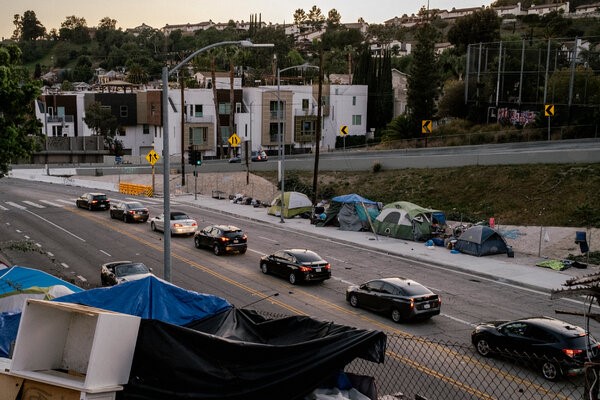
| Story by German Lopez of the New York Times, July 15, 2022 |
| A housing shortfall America’s homelessness problem has the makings of an acute crisis. Shelters across the U.S. are reporting a surge in people looking for help, with wait lists doubling or tripling in recent months. The number of homeless people outside of shelters is also probably rising, experts say. Some of them live in encampments, which have popped up in parks and other public spaces in major cities from Washington, D.C., to Seattle since the pandemic began. And inflation is compounding the problem: Rent has increased at its fastest rate since 1986, putting houses and apartments out of reach for more Americans. The crisis means more people do not know where they will sleep tonight. Living in the streets, people are exposed to more crime, violence and bad weather, including extreme heat. They can lose their job in the chaos of homelessness, and they often struggle to find another one without access to the internet or a mailing address. “There’s a certain posture that you take when you are homeless,” Ivan Perez, who lived in a tent in Los Angeles, told The Times. “You lose your dignity.” Homelessness has become a particularly bad political problem for the Democrats who govern big cities, where it is most visible. It has played a role in recent elections, like the recall of San Francisco’s district attorney last month. More Americans now say they worry a great deal about homelessness compared with the years before the pandemic. The origins of the current homelessness crisis go back decades — to policies that stopped the U.S. from building enough housing, experts said. Seven million extremely low-income renters cannot get affordable homes, according to the National Low Income Housing Coalition. Today’s newsletter will look at how the country got to this point. Supply and demand No factor matters more to homelessness than access to housing. Poverty, mental illness, addiction and other issues do play roles, but they are less significant. Many cities and states in the Midwest and South, for example, have higher rates of mental illness, poverty or addiction than other parts of the U.S., but they have similar or lower rates of homelessness. “What explains regional variation is housing market conditions,” said Gregg Colburn, a housing expert at the University of Washington. Housing researchers use the example of musical chairs: Imagine there are 10 people for nine chairs. One person, weighed down by poor health, does not make it to a chair. Is the problem that person’s health or the lack of chairs? Homelessness, then, is a supply-and-demand problem. Without enough housing, not everyone has a place to live. And the homes that do exist cost more as people compete for limited supply. So more people are priced out, and more end up homeless. Policy failures Policymakers have made the crisis worse, instituting laws and zoning rules that limit the number of available homes. Consider California. Los Angeles County allocates 76 percent of its residential land to single-family housing, while the San Francisco Bay Area allocates 85 percent. Historically, this has made it difficult to build more housing: Most plots are reserved for only one family, instead of duplexes or apartment buildings that can house many more. Homeowners also often protest proposed housing, effectively blocking it. They fear that more housing, particularly for low-income families, will change the makeup of their communities or reduce the value of their homes. In San Francisco, for example, protests recently stopped a project to convert a 131-room Japantown hotel into housing units for homeless people. The combination of zoning rules and local protests has added to a housing deficit year after year, as growing populations have outpaced new homes built. Now, California has 23 available affordable homes for every 100 extremely low-income renters — among the worst rates of any state. What’s next Some cities and states have begun confronting the issue. California and Oregon passed laws in recent years to effectively end single-family zoning. But homelessness took decades to get to this level, and it will probably take years to fully address. And while homelessness is largely associated with Democratic-run cities in Democratic-run states, that appears to be changing as more Americans flock to the Sun Belt and the West. If traditionally red states in these areas repeat the same mistakes as their coastal counterparts, they could set themselves up for a crisis in the future. |
